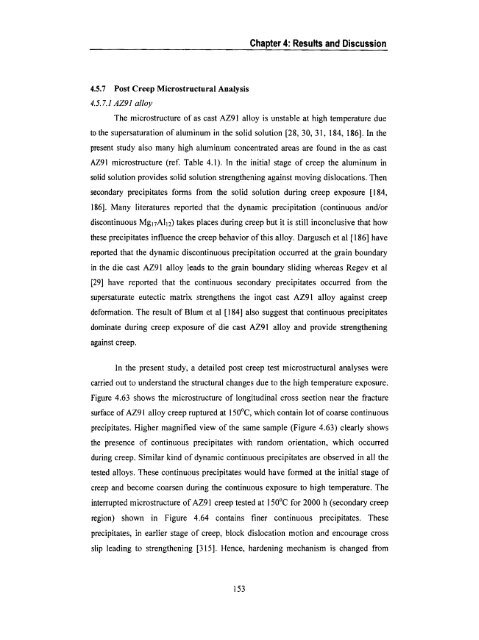“Influence of Si, Sb and Sr Additions on the Microstructure ...
“Influence of Si, Sb and Sr Additions on the Microstructure ...
“Influence of Si, Sb and Sr Additions on the Microstructure ...
You also want an ePaper? Increase the reach of your titles
YUMPU automatically turns print PDFs into web optimized ePapers that Google loves.
4.5.7 Post Creep Microstructural Analysis<br />
4.5.7.1 AZ91 alloy<br />
Chapter 4: Results <str<strong>on</strong>g>and</str<strong>on</strong>g> Discussi<strong>on</strong><br />
The microstructure <str<strong>on</strong>g>of</str<strong>on</strong>g> as cast AZ9l alloy is unstable at high temperature due<br />
to <strong>the</strong> supersaturati<strong>on</strong> <str<strong>on</strong>g>of</str<strong>on</strong>g> aluminum in <strong>the</strong> solid soluti<strong>on</strong> [28, 30, 31, 184, 186]. In <strong>the</strong><br />
present study also many high aluminum c<strong>on</strong>centrated areas are found in <strong>the</strong> as cast<br />
AZ9l microstructure (ref. Table 4.1). In <strong>the</strong> initial stage <str<strong>on</strong>g>of</str<strong>on</strong>g> creep <strong>the</strong> aluminum in<br />
solid soluti<strong>on</strong> provides solid soluti<strong>on</strong> streng<strong>the</strong>ning against moving dislocati<strong>on</strong>s. Then<br />
sec<strong>on</strong>dary precipitates forms from <strong>the</strong> solid soluti<strong>on</strong> during creep exposure [l84,<br />
186]. Many literatures reported that <strong>the</strong> dynamic precipitati<strong>on</strong> (c<strong>on</strong>tinuous <str<strong>on</strong>g>and</str<strong>on</strong>g>/or<br />
disc<strong>on</strong>tinuous Mg11Al1;) takes places during creep but it is still inc<strong>on</strong>clusive that how<br />
<strong>the</strong>se precipitates influence <strong>the</strong> creep behavior <str<strong>on</strong>g>of</str<strong>on</strong>g> this alloy. Dargusch et al [186] have<br />
reported that <strong>the</strong> dynamic disc<strong>on</strong>tinuous precipitati<strong>on</strong> occurred at <strong>the</strong> grain boundary<br />
in <strong>the</strong> die cast AZ9l alloy leads to <strong>the</strong> grain boundary sliding whereas Regev et al<br />
[29] have reported that <strong>the</strong> c<strong>on</strong>tinuous sec<strong>on</strong>dary precipitates occurred from <strong>the</strong><br />
supersaturate eutectic matrix streng<strong>the</strong>ns <strong>the</strong> ingot cast AZ9l alloy against creep<br />
deformati<strong>on</strong>. The result <str<strong>on</strong>g>of</str<strong>on</strong>g> Blum et al [184] also suggest that c<strong>on</strong>tinuous precipitates<br />
dominate during creep exposure <str<strong>on</strong>g>of</str<strong>on</strong>g> die cast AZ9l alloy <str<strong>on</strong>g>and</str<strong>on</strong>g> provide streng<strong>the</strong>ning<br />
against creep.<br />
In <strong>the</strong> present study, a detailed post creep test microstructural analyses were<br />
carried out to underst<str<strong>on</strong>g>and</str<strong>on</strong>g> <strong>the</strong> structural changes due to <strong>the</strong> high temperature exposure.<br />
Figure 4.63 shows <strong>the</strong> microstructure <str<strong>on</strong>g>of</str<strong>on</strong>g> l<strong>on</strong>gitudinal cross secti<strong>on</strong> near <strong>the</strong> fracture<br />
surface <str<strong>on</strong>g>of</str<strong>on</strong>g> AZ9l alloy creep ruptured at 150°C, which c<strong>on</strong>tain lot <str<strong>on</strong>g>of</str<strong>on</strong>g> coarse c<strong>on</strong>tinuous<br />
precipitates. Higher magnified view <str<strong>on</strong>g>of</str<strong>on</strong>g> <strong>the</strong> same sample (Figure 4.63) clearly shows<br />
<strong>the</strong> presence <str<strong>on</strong>g>of</str<strong>on</strong>g> c<strong>on</strong>tinuous precipitates with r<str<strong>on</strong>g>and</str<strong>on</strong>g>om orientati<strong>on</strong>, which occurred<br />
during creep. <str<strong>on</strong>g>Si</str<strong>on</strong>g>milar kind <str<strong>on</strong>g>of</str<strong>on</strong>g> dynamic c<strong>on</strong>tinuous precipitates are observed in all <strong>the</strong><br />
tested alloys. These c<strong>on</strong>tinuous precipitates would have formed at <strong>the</strong> initial stage <str<strong>on</strong>g>of</str<strong>on</strong>g><br />
creep <str<strong>on</strong>g>and</str<strong>on</strong>g> become coarsen during <strong>the</strong> c<strong>on</strong>tinuous exposure to high temperature. The<br />
interrupted microstructure <str<strong>on</strong>g>of</str<strong>on</strong>g> AZ9l creep tested at 150°C for 2000 h (sec<strong>on</strong>dary creep<br />
regi<strong>on</strong>) shown in Figure 4.64 c<strong>on</strong>tains finer c<strong>on</strong>tinuous precipitates. These<br />
precipitates, in earlier stage <str<strong>on</strong>g>of</str<strong>on</strong>g> creep, block dislocati<strong>on</strong> moti<strong>on</strong> <str<strong>on</strong>g>and</str<strong>on</strong>g> encourage cross<br />
slip leading to streng<strong>the</strong>ning [3l5]. Hence, hardening mechanism is changed from<br />
153
















